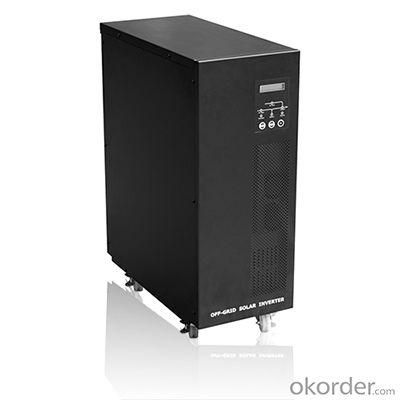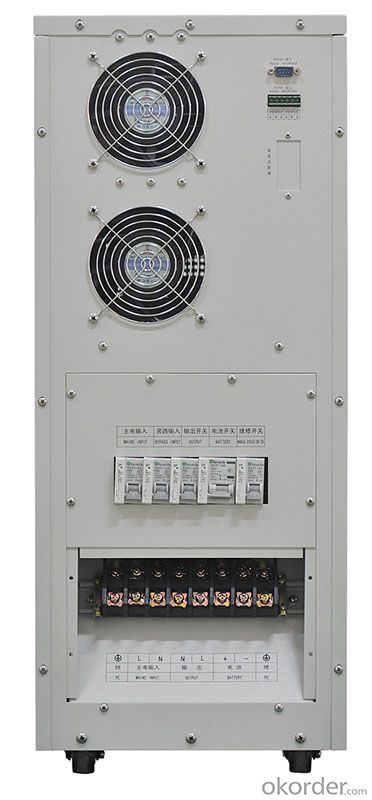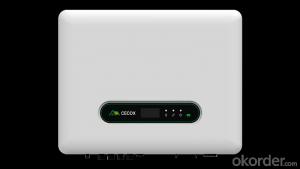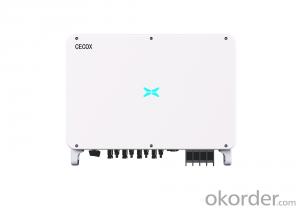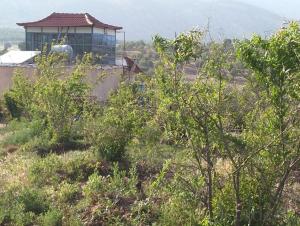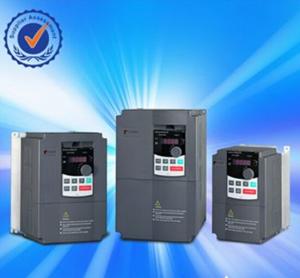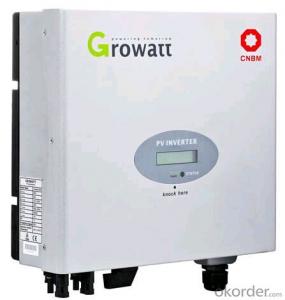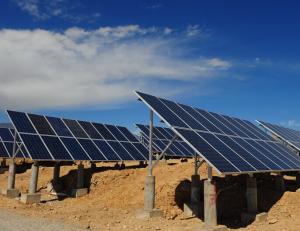Solar Inverter Perth - Off-grid Solar Inverter 3kw-8kw CE Approved AAA Quality with Best Price
- Loading Port:
- China main port
- Payment Terms:
- TT or LC
- Min Order Qty:
- 1 pc
- Supply Capability:
- 1000 pc/month
OKorder Service Pledge
OKorder Financial Service
You Might Also Like
Off-Grid Solar Inverter 3KW-8KW
EA-GF series products are on the basis of green energy use and equipment electricity need for remote area, combing the electricity characteristics of household appliances, communication station equipment and computer peripheral equipment. They have the function of energy conservation and environment protection. They adopt MCU control technique, having various kinds of function such as multi-setting mode, MPPT control, voltage stabilization on line, short-circuit protection, inverter frequency adaptive, output overload, battery charging management, monitoring etc. With display of LCD and LED, all the parameters and running status could be visible. Intelligent monitor is available via RS232 &USB connecting with PC, while remote control via RS485 &SNMP. EA-GF series products are the ideal power supply delivered with excellent performance, high stability, high reliability and high practical applicability
● Multi-setting
※PV priority mode or AC priority mode
※Choose the charging current based on the configured capacity of the battery
● High reliability: Double MCU digital control
※Independent MPPT (Maximum Power Point Tracking) control microprocessor system
※Independent inverter microprocessor control system
● Isolated and pure sine wave technology
● LCD+LED display
● Wide input range
● High-speed synchronous conversion
● Friendly alarm system
● Online protection function
● Frequency auto adaptive
● Intelligent No-load auto shutdown technology (optional)
● Intelligent monitoring (RS232, USB, or SNMP card, optional)
Model | GF3000 | GF4000 | GF3000 | GF5000 | GF6000 | GF8000 |
Power | 3KW | 4KW | 3KW | 5KW | 6KW | 8KW |
Battery Voltage | 96Vdc | 192Vdc | ||||
Working Mode | PV priority / AC priority optional | |||||
PV | ||||||
MPPT Voltage Range | 96Vdc - 200Vdc | 192Vdc - 400Vdc | ||||
Max. Charge Current | 10-60A | 10-40A | 10-60A | |||
PV Panels Configuration(Suggestion)(Vmp) | 120-142Vdc | 240-284Vdc | ||||
PV Panels Configuration(Suggestion)(Imp) | ≤60A | ≤40A | ≤60A | |||
Conversion Efficiency | ≥ 98 % | |||||
Display | ||||||
Panel Indicator | LCD+LED Panel display | |||||
AC Mode | ||||||
Input Voltage Range | 165Vac- 275Vac | |||||
Input Frequency Range | 40-70 Hz (auto transfer to battery mode, if beyond this range) | |||||
Output Voltage Precision | 220Vac± 5% | |||||
Input Power Factor | ≥0.8 | |||||
Max. Efficiency | 88% (inverter on) | |||||
Overload | 110% transfer to bypass in 255s,120% go to bypass in 60s, 150% go to bypass in 10s. | |||||
Max. Charging Current | 8A | 12A | ||||
Short Circuit Protection | Electronic limited current output or turn bypass, air breaker protection | |||||
Inverter Mode | ||||||
Output Voltage | 220Vac± 5% | |||||
Output Frequency | 50 Hz / 60Hz ± 1% Frequency self-adjusted | |||||
Output Power Factor | 1 | |||||
Distortion | ≤ 5% Linear load | |||||
PV-AC Transfer Time | 0ms | |||||
Max.Efficiency | ≥92% | |||||
Overload | 110% transfer to bypass, in 255s or shut down,120% go to bypass or shut down in 60s, 150% go to bypass or shut down in 10s. | |||||
Eco Mode(Optional) | When Load < 5%, system will turn to bypass power supply (utility) in 1min | |||||
Short Circuit | Electronic limited current output, turn the bypass or system to be automatic shutdown | |||||
Alarm | ||||||
AC Fails | 1/4s; automatic sound elimination after 40s | |||||
Battery Low Voltage | 5/1s | |||||
Overload | 1/1s | |||||
Communication (Optional) | ||||||
Communication Interface | RS232 / USB / RS485 / SNMP | |||||
Dry Contact | PV failure、battery low-voltage、overload、bypass、inverter failure、 remote start generator dry contact signal | |||||
Others | ||||||
Output Connection | Terminal blocks | |||||
Surge Protection | Optional | |||||
EMC | Accord with EN62040-2:2006;EN61000-3-2:2006; EN61000-3-3:2008 | |||||
IP Class | IP20 | |||||
Ambient Temperature | 0℃ ~ 40℃ | |||||
Ambient Humidity | 10% ~ 90%(Non Condensed) | |||||
Noise | ≤ 50dB | |||||
Working Altitude | 2000m (Every 100m increase derating 1%) | |||||
Dimension (WxDxH)mm | 560×265×725 | |||||
Packing Dimension (WxDxH)mm | 662×360×905 | |||||
Weight(kg) | 76 | 80 | 60 | 67 | 69 | 85 |
Packing Weight(kg) | 85 | 89 | 69 | 76 | 78 | 94 |
· Q. What is an UPS and What it is for ?
An uninterruptible power supply (UPS) is a device that allows your computer or telephone switch or critical equipement to keep running for at least a short time or longer time when the primary power source is lost. It also provides protection from power surges, spikes, brownouts, interference and other unwanted problems on the supported equipment.
· Q. How long the UPS to run when power goes?
This can take 3 paths.
1.You can pick a UPS that is rated for pretty much the full VA you need so it will be running at 100% of capability and will thus last 'n' minutes.
2.You can pick a UPS that is rated at a much higher VA value than you really need so, for example, is running at 50% of capability and will thus last for longer than the UPS from option 1.
3.You can use extra external battery packs to run for longer. If charging capability allows, the more and the bigger batteries you take with, the longer time UPS runs.
or using a generator after about 6 hours, it will be more cost-effective, with a short runtime UPS to bridge the generator start-up gap.


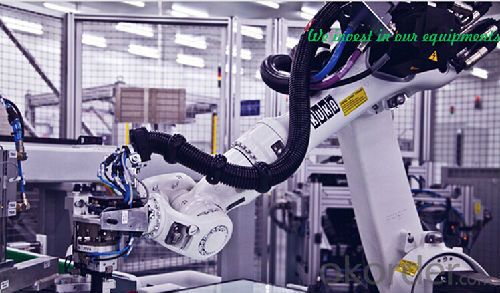


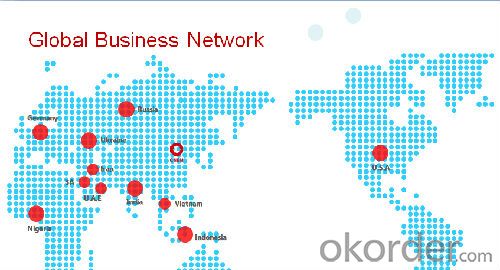
- Q: Can a solar inverter be used in conjunction with a smart home system?
- Yes, a solar inverter can be used in conjunction with a smart home system. Many modern solar inverters are equipped with communication protocols such as Wi-Fi or Zigbee, allowing them to connect to a smart home system. This integration enables users to monitor and control their solar energy production, consumption, and storage conveniently through their smart home devices or applications.
- Q: How does a solar inverter handle grid faults or disturbances?
- A solar inverter handles grid faults or disturbances by constantly monitoring the grid voltage and frequency. When a fault or disturbance is detected, the solar inverter will disconnect from the grid within a few milliseconds to ensure the safety and stability of the system. It will then enter a standby mode until the grid fault is resolved. Once the grid is back to normal, the solar inverter will reconnect and resume normal operation, providing power to the grid and maintaining synchronization.
- Q: Can a solar inverter be used in areas with high levels of electromagnetic interference (EMI)?
- Yes, a solar inverter can be used in areas with high levels of electromagnetic interference (EMI). However, it is important to ensure that the inverter is designed and equipped to handle such conditions. Certain models of solar inverters are specifically designed to mitigate the effects of EMI and provide reliable performance even in challenging electromagnetic environments.
- Q: Can a solar inverter be used in standalone systems?
- Yes, a solar inverter can be used in standalone systems. Standalone systems, also known as off-grid systems, are not connected to the electrical grid and rely on alternative sources of power such as solar panels. Solar inverters are crucial in standalone systems as they convert the direct current (DC) produced by the solar panels into alternating current (AC) that is used to power household or commercial appliances.
- Q: What is the maximum power capacity that a solar inverter can handle?
- The maximum power capacity that a solar inverter can handle depends on its specific model and specifications. In general, solar inverters can handle power capacities ranging from a few hundred watts to several megawatts, catering to various residential, commercial, and utility-scale solar installations.
- Q: How does a solar inverter handle voltage sag and swell?
- A solar inverter handles voltage sag and swell by utilizing its power conditioning capabilities. When it detects a voltage sag (a temporary decrease in voltage), the inverter adjusts its internal control algorithms to provide a stable and consistent output voltage to the connected loads. Similarly, in the case of voltage swell (a temporary increase in voltage), the inverter modifies its operation to prevent overvoltage conditions and ensure a safe and regulated output. Through continuous monitoring and intelligent control, a solar inverter effectively manages voltage fluctuations to maintain stable power delivery.
- Q: What is the role of a galvanic isolation circuit in a solar inverter?
- The role of a galvanic isolation circuit in a solar inverter is to provide a barrier of protection between the high-voltage DC input from the solar panels and the low-voltage AC output. It ensures electrical safety by isolating the input and output circuits, preventing any direct electrical connection or potential leakage current. This isolation helps to prevent electrical faults, ground loops, and potential damage to the solar inverter or connected equipment, while also reducing the risk of electrical shock.
- Q: What is the maximum number of solar panels that can be connected to a single inverter?
- The maximum number of solar panels that can be connected to a single inverter depends on the inverter's capacity and the specifications provided by the manufacturer. It can vary widely based on factors such as the wattage rating of the inverter, the voltage and current output of the solar panels, and the electrical compatibility between them. It is important to consult the manufacturer's guidelines or seek professional advice to determine the appropriate number of panels for a specific inverter.
- Q: Can a solar inverter be used with a solar-powered cooling system?
- Yes, a solar inverter can be used with a solar-powered cooling system. A solar inverter is responsible for converting the direct current (DC) electricity generated by solar panels into alternating current (AC) electricity that can be used to power various appliances, including cooling systems. By integrating a solar inverter into a solar-powered cooling system, the system can effectively harness solar energy to operate and provide cooling without relying on external power sources.
- Q: Are solar inverters compatible with smart home systems?
- Yes, solar inverters are compatible with smart home systems. In fact, many modern solar inverters are designed to integrate seamlessly with smart home technology, allowing homeowners to monitor and control their solar energy production and consumption through their smart devices. This integration enables better energy management, increased efficiency, and the ability to optimize the use of solar power within a smart home ecosystem.
Send your message to us
Solar Inverter Perth - Off-grid Solar Inverter 3kw-8kw CE Approved AAA Quality with Best Price
- Loading Port:
- China main port
- Payment Terms:
- TT or LC
- Min Order Qty:
- 1 pc
- Supply Capability:
- 1000 pc/month
OKorder Service Pledge
OKorder Financial Service
Similar products
Hot products
Hot Searches
Related keywords



